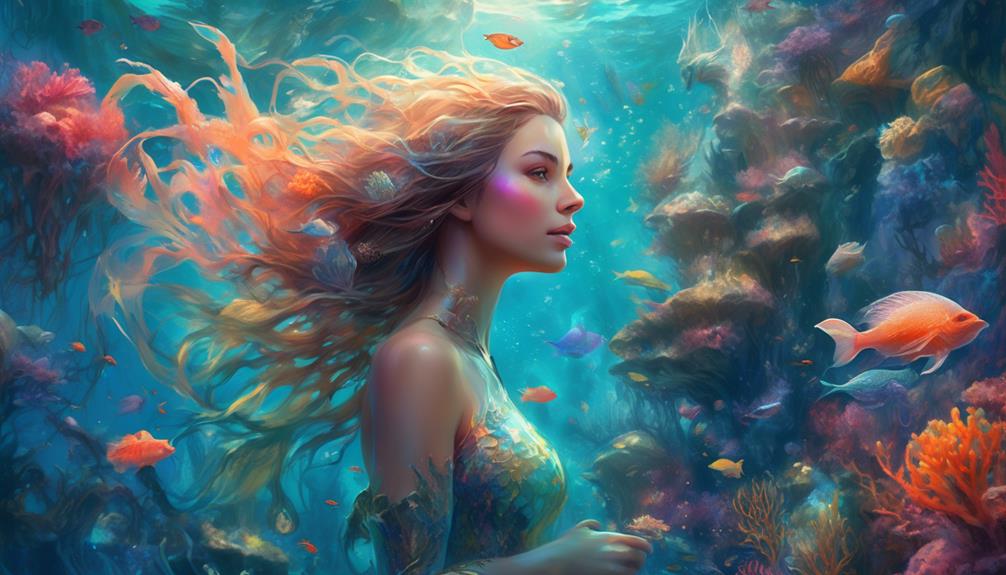Mermaids, the mythical sea maidens of folklore and legend, have captivated the human imagination for centuries with their enchanting allure and mysterious presence. While often dismissed as purely fictional beings, marine biologists have begun to uncover intriguing evidence that may shed light on the origins of these aquatic creatures.
Through a scientific lens, these experts are unraveling the biological basis for mermaid tales, exploring the behaviors of aquatic humanoids, and delving into the intriguing connection between siren calls and marine life.
As their research continues to unravel the mysteries of the deep, it becomes increasingly clear that the allure of mermaids may be more than just a figment of imagination.
Key Takeaways
- Mermaids have been a recurring theme in art, literature, and folklore, representing enchanting and mysterious creatures with a human upper body and fish lower body.
- The symbolism of mermaids varies across cultures and reflects changing societal attitudes towards femininity and the sea.
- Scientific inquiry into the origins of mermaid legends suggests biological explanations such as evolutionary adaptations, genetic disorders, and inspiration from marine mammals like manatees and dugongs.
- Studying aquatic humanoid behaviors, including communication methods, social interactions, and cooperative hunting, can provide insights into the potential social dynamics of these creatures.
Historical Depictions of Mermaids
Historical depictions of mermaids have been a recurring theme in art, literature, and folklore across cultures and time periods. Mermaid folklore, deeply rooted in maritime communities, often portrays these mythical beings as enchanting and mysterious creatures with the upper body of a human and the lower body of a fish.
Their symbolism varies widely, representing themes of love, seduction, and perilous beauty in some cultures, while in others, they're seen as omens of misfortune or as protectors of sailors. The evolution of mermaid depictions reflects changing societal attitudes towards femininity, the sea, and human-animal relationships.
As an enduring motif in human imagination, mermaids continue to capture the interest of both scholars and the public, serving as a window into the intersection of myth, culture, and the natural world.
Biological Basis for Mermaid Legends
The biological basis for mermaid legends has been a subject of scientific inquiry and speculation due to the enduring fascination with these mythical creatures. While mermaids are often considered purely mythical, some have suggested that the legends may have been influenced by real biological phenomena.
Evolutionary adaptations and genetic anomalies have been proposed as potential explanations for mermaid sightings and stories. For example, certain marine mammals such as manatees and dugongs, with their human-like faces and curvaceous bodies, might've inspired mermaid tales.
Additionally, genetic disorders like sirenomelia, a rare congenital condition characterized by fused legs, could have contributed to the mermaid mythos.
Exploring the biological underpinnings of mermaid legends offers a fascinating intersection between folklore and scientific inquiry.
Aquatic Humanoid Behaviors
The examination of aquatic humanoid behaviors provides a natural extension of the biological exploration into the origins of mermaid legends, shedding light on potential real-world behaviors that could have inspired or perpetuated these mythical tales.
When considering communication methods, it's essential to analyze potential vocalizations or non-verbal cues that could have been interpreted as language or signaling.
Additionally, studying social interactions among aquatic creatures could offer insight into the ways in which mermaid-like beings might've interacted with each other or other marine species. Observing behaviors such as cooperative hunting, mating rituals, or group formations could provide clues about the potential social dynamics of aquatic humanoids.
Siren Calls and Marine Life
Siren calls in marine environments have long fascinated researchers due to their potential impact on the behavior and communication patterns of various marine species.
The study of siren behavior and its influence on marine communication has revealed intriguing insights. Siren calls, often associated with mythical sea maidens, are believed to have evolved as a means of communication and social interaction among certain marine species. These calls can serve various purposes, such as mating rituals, warning signals, or territorial claims.
Understanding the intricacies of siren behavior is crucial for comprehending the dynamics of marine ecosystems. Furthermore, the study of siren calls and their effects on marine life provides valuable information for conservation efforts and the management of marine resources.
Mermaid Sightings and Misidentifications
Mermaid sightings and misidentifications have intrigued researchers as they seek to understand the potential influence of folklore and human perception on reported observations of marine creatures.
The intertwining of mermaid folklore with actual marine biology has led to instances of misidentification. Cultural significance and the perpetuation of mermaid legends have undoubtedly played a role in these sightings.
The human tendency to perceive familiar shapes and patterns in ambiguous stimuli, known as pareidolia, may also contribute to reported mermaid sightings.
Furthermore, manatees and dugongs, with their human-like flippers and propensity to bask near the water's surface, have been suggested as potential candidates for mermaid misidentifications.
As marine biology continues to unravel the mysteries of the ocean, understanding the cultural and psychological aspects of mermaid folklore and sightings remains an intriguing area of study.
Mermaid Conservation Efforts
Conservation efforts for mermaids focus on preserving the habitats and ecosystems crucial to their survival, addressing anthropogenic threats to these environments.
Marine habitats play a vital role in the lives of mermaids, and thus conservation strategies are aimed at protecting these areas from pollution, overfishing, and habitat destruction.
Efforts also include raising awareness about the importance of these habitats and promoting sustainable practices in marine resource management.
Conservationists work towards establishing marine protected areas and implementing regulations to safeguard mermaid habitats.
Additionally, research into the ecological requirements of mermaids helps inform conservation strategies, ensuring that their specific needs are met within their natural environments.
Frequently Asked Questions
Are There Any Known Instances of Mermaids Attacking or Harming Humans in History or in Modern Times?
Mermaids in folklore, literature, art, history, and modern times have not been documented to attack or harm humans. Despite being mythical creatures, no scientific evidence supports the existence of aggressive mermaids in any time period.
What Are the Most Common Misconceptions About Mermaids That Have Been Perpetuated by Popular Culture?
Common misconceptions about mermaids, perpetuated by popular culture, include supernatural powers, historical attacks, and cultural portrayals. These myths have overshadowed the reality of marine biology, leading to widespread misunderstandings.
Can Mermaids Communicate With Other Marine Creatures, and if So, How Do They Do It?
Mermaid intelligence is a subject of intrigue. Marine biologists study their communication techniques to understand if they can interact with other marine creatures. Observations suggest that mermaids may use a combination of vocalizations, body language, and possibly even bioelectric signals to communicate.
Is There Any Evidence to Suggest That Mermaids Possess Supernatural Abilities or Powers?
There is no scientific evidence to support the existence of supernatural abilities in mermaids. Global folklore often portrays mermaids as enchanting creatures, but historical attacks are likely misinterpretations of known marine wildlife behavior.
How Do Different Cultures Around the World View and Portray Mermaids in Their Folklore and Mythology?
Cultural depictions of mermaids vary widely, reflecting diverse artistic interpretations and folklore variations. Historical encounters and scientific explanations have contributed to myth debunking. Supernatural abilities and communication methods are recurrent themes in global mermaid lore.

